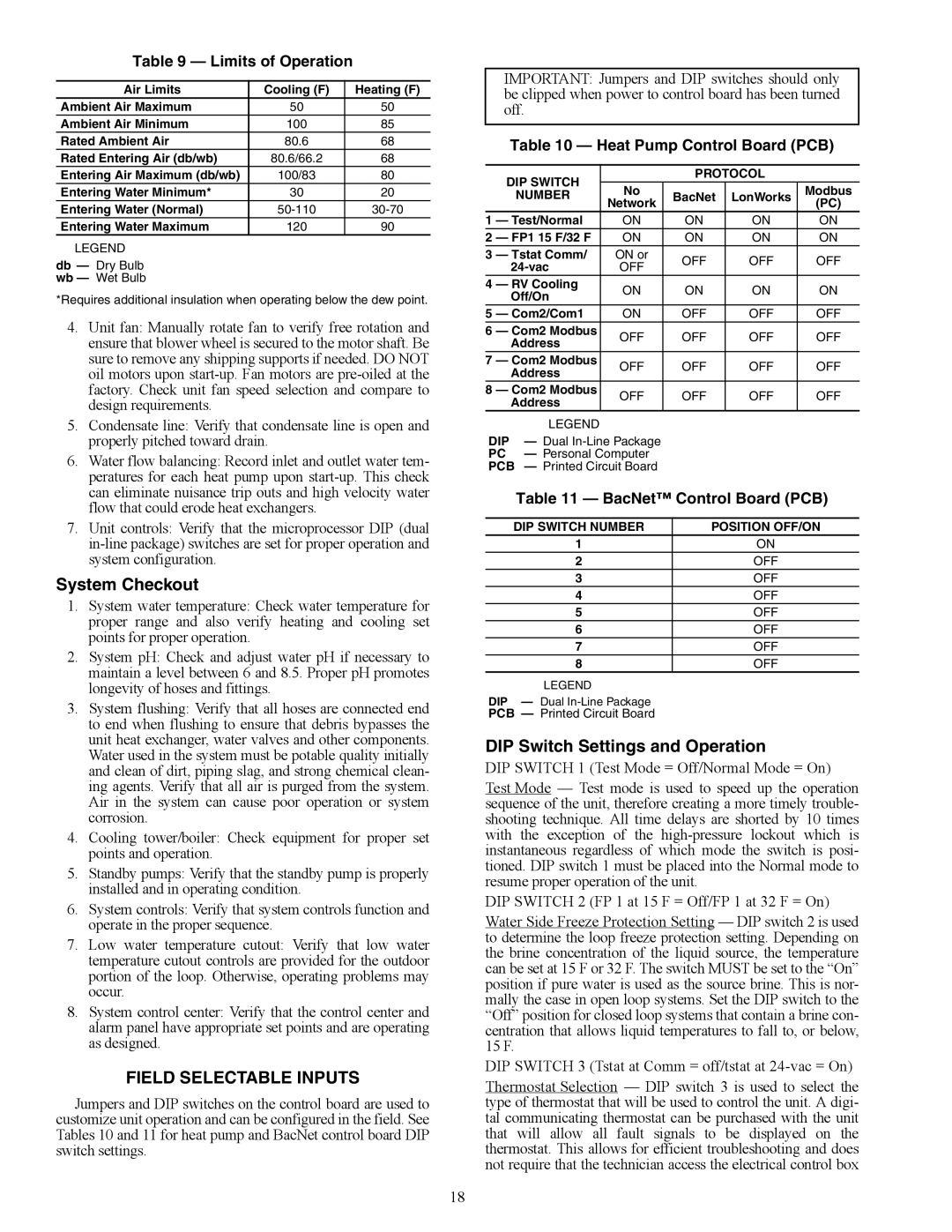Table 9 — Limits of Operation
Air Limits | Cooling (F) | Heating (F) |
Ambient Air Maximum | 50 | 50 |
Ambient Air Minimum | 100 | 85 |
Rated Ambient Air | 80.6 | 68 |
Rated Entering Air (db/wb) | 80.6/66.2 | 68 |
Entering Air Maximum (db/wb) | 100/83 | 80 |
Entering Water Minimum* | 30 | 20 |
Entering Water (Normal) | ||
Entering Water Maximum | 120 | 90 |
LEGEND |
|
|
db — Dry Bulb wb — Wet Bulb
*Requires additional insulation when operating below the dew point.
4.Unit fan: Manually rotate fan to verify free rotation and ensure that blower wheel is secured to the motor shaft. Be sure to remove any shipping supports if needed. DO NOT oil motors upon
5.Condensate line: Verify that condensate line is open and properly pitched toward drain.
6.Water flow balancing: Record inlet and outlet water tem- peratures for each heat pump upon
7.Unit controls: Verify that the microprocessor DIP (dual
System Checkout
1.System water temperature: Check water temperature for proper range and also verify heating and cooling set points for proper operation.
2.System pH: Check and adjust water pH if necessary to maintain a level between 6 and 8.5. Proper pH promotes longevity of hoses and fittings.
3.System flushing: Verify that all hoses are connected end to end when flushing to ensure that debris bypasses the unit heat exchanger, water valves and other components. Water used in the system must be potable quality initially and clean of dirt, piping slag, and strong chemical clean- ing agents. Verify that all air is purged from the system. Air in the system can cause poor operation or system corrosion.
4.Cooling tower/boiler: Check equipment for proper set points and operation.
5.Standby pumps: Verify that the standby pump is properly installed and in operating condition.
6.System controls: Verify that system controls function and operate in the proper sequence.
7.Low water temperature cutout: Verify that low water temperature cutout controls are provided for the outdoor portion of the loop. Otherwise, operating problems may occur.
8.System control center: Verify that the control center and alarm panel have appropriate set points and are operating as designed.
FIELD SELECTABLE INPUTS
Jumpers and DIP switches on the control board are used to customize unit operation and can be configured in the field. See Tables 10 and 11 for heat pump and BacNet control board DIP switch settings.
IMPORTANT: Jumpers and DIP switches should only be clipped when power to control board has been turned off.
Table 10 — Heat Pump Control Board (PCB)
| DIP SWITCH |
| PROTOCOL |
| |
| NUMBER | No | BacNet | LonWorks | Modbus |
|
| Network |
|
| (PC) |
1 | — Test/Normal | ON | ON | ON | ON |
2 | — FP1 15 F/32 F | ON | ON | ON | ON |
3 | — Tstat Comm/ | ON or | OFF | OFF | OFF |
| OFF | ||||
|
|
|
| ||
4 | — RV Cooling | ON | ON | ON | ON |
| Off/On | ||||
|
|
|
|
| |
5 | — Com2/Com1 | ON | OFF | OFF | OFF |
6 | — Com2 Modbus | OFF | OFF | OFF | OFF |
| Address | ||||
|
|
|
|
| |
7 | — Com2 Modbus | OFF | OFF | OFF | OFF |
| Address | ||||
|
|
|
|
| |
8 | — Com2 Modbus | OFF | OFF | OFF | OFF |
| Address | ||||
|
|
|
|
| |
| LEGEND |
|
|
|
|
DIP — Dual
PC — Personal Computer
PCB — Printed Circuit Board
Table 11 — BacNet™ Control Board (PCB)
DIP SWITCH NUMBER | POSITION OFF/ON |
1 | ON |
2 | OFF |
3 | OFF |
4 | OFF |
5 | OFF |
6 | OFF |
7 | OFF |
8 | OFF |
LEGEND
DIP — Dual
PCB — Printed Circuit Board
DIP Switch Settings and Operation
DIP SWITCH 1 (Test Mode = Off/Normal Mode = On)
Test Mode — Test mode is used to speed up the operation sequence of the unit, therefore creating a more timely trouble- shooting technique. All time delays are shorted by 10 times with the exception of the
DIP SWITCH 2 (FP 1 at 15 F = Off/FP 1 at 32 F = On)
Water Side Freeze Protection Setting — DIP switch 2 is used to determine the loop freeze protection setting. Depending on the brine concentration of the liquid source, the temperature can be set at 15 F or 32 F. The switch MUST be set to the “On” position if pure water is used as the source brine. This is nor- mally the case in open loop systems. Set the DIP switch to the “Off” position for closed loop systems that contain a brine con- centration that allows liquid temperatures to fall to, or below, 15 F.
DIP SWITCH 3 (Tstat at Comm = off/tstat at
Thermostat Selection — DIP switch 3 is used to select the type of thermostat that will be used to control the unit. A digi- tal communicating thermostat can be purchased with the unit that will allow all fault signals to be displayed on the thermostat. This allows for efficient troubleshooting and does not require that the technician access the electrical control box
18
